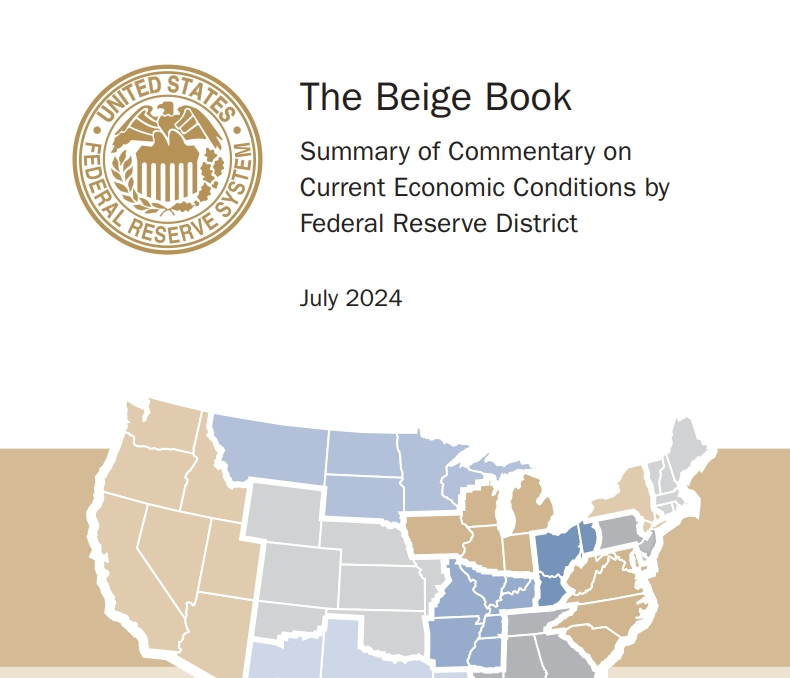Fed's July Beige Book: Economic Growth Will Slow Over Next 6 Months
Economic growth is expected to slow in the next six months due to upcoming elections, domestic policies, geopolitical conflicts and inflation uncertainty.
On July 17, the Federal Reserve released the economic conditions survey report (Beige Book) for the period from late May to June.

Among the 12 regional Federal Reserves, economic activity increased in 7 regions, remained flat or declined in 5. Compared to the May data, three additional regions reported flat or declining economic activity—indicating that under high interest rates, the U.S. economic growth has shown signs of slowing down during the reporting period.
In terms of inflation, which the Federal Reserve is concerned about, the report states: prices generally rose moderately, but in some areas, the increase was only slight. Consumer spending did not change much, and retailers generally reported an increase in discounts, with consumers being more sensitive to prices, tending to buy necessities or seek cost-effective deals. The Federal Reserve said that as demand weakens, businesses' ability to raise prices without driving away customers has weakened. Although the cost of food and commodities basically remained unchanged, the prices of freight and some building materials rose.
In terms of labor, during the reporting period, employment rates in most regions remained flat or slightly increased, while in some regions, they declined, with only a few regions showing a moderate increase in employment. The shortage of skilled workers remains a challenge in all regions, especially in construction, maintenance, retail, healthcare, and tourism, but in several regions, the labor supply situation has improved, and the labor turnover rate has also decreased, reducing the need to hire new workers. Several regions are expected to be more cautious in hiring and will not fill all vacant positions. Companies continue to turn to automation and outsourcing to save money and compensate for actual or expected labor shortages.
Regarding wages related to inflation, the report states that in most regions, wages increased at a "modest to moderate" pace, and in a few regions, the increased availability of workers and reduced competition for labor led to slower wage growth. This statement has cooled down compared to the May report.
There is little change in household spending. Most regions have weak demand for consumer and commercial loans. Reports on the residential and commercial real estate markets vary, but most banks in the regions have only reported slight changes in recent weeks.
Looking at the industry, the tourism industry is growing steadily, close to seasonal expectations. Agricultural conditions vary with occasional droughts across the United States. Manufacturing activities in different regions show completely different trends, from being sluggish to moderate growth. Retail restocking has stimulated a slight increase in transportation activity. At the same time, the tight capacity of sea freight has led to a surge in spot rates.
The report also states that due to the upcoming elections, domestic policy, geopolitical conflicts, and the uncertainty of inflation, economic growth is expected to slow down in the next six months—this is undoubtedly good news for the Federal Reserve, which is eager to see progress in inflation.
Affected by pessimistic expectations, after the release of the Federal Reserve's Beige Book, the U.S. dollar index continued to decline during the day, stabilizing at the lowest point since late March for nearly four months; the volatile two-year U.S. Treasury yield plummeted in the short term, reaching the lowest point in nearly five months, and the ten-year Treasury yield continued to hover at a four-month low.
The performance of the U.S. stock market was a big surprise. As of last night's closing, only the Dow Jones Industrial Average set a new historical high, rising 0.59% to 41,198.08 points; the S&P 500 index fell 1.39% to 5,588.27 points, the largest single-day decline since April 30; the Nasdaq fell 2.77% to 17,996.92 points, the largest single-day decline since December 2022. The Philadelphia Semiconductor Index plummeted 6.81%, the largest single-day decline since March 2020.
Analysts say that unfavorable seasonal factors, excessive positions, and the digestion of all good news by the market have put the S&P 500 index on the edge of a summer correction.
As of the time of writing, according to the CME "Fed Watch," the probability of the Federal Reserve keeping interest rates unchanged in August is 96.4%, and the probability of cutting interest rates by 25 basis points is 3.6%. The probability of the Federal Reserve keeping interest rates unchanged in September is only 1.0%, the probability of a cumulative cut of 25 basis points is 95.5%, and the probability of a cumulative cut of 50 basis points is 3.6%.
·Original
Disclaimer: The views in this article are from the original Creator and do not represent the views or position of Hawk Insight. The content of the article is for reference, communication and learning only, and does not constitute investment advice. If it involves copyright issues, please contact us for deletion.